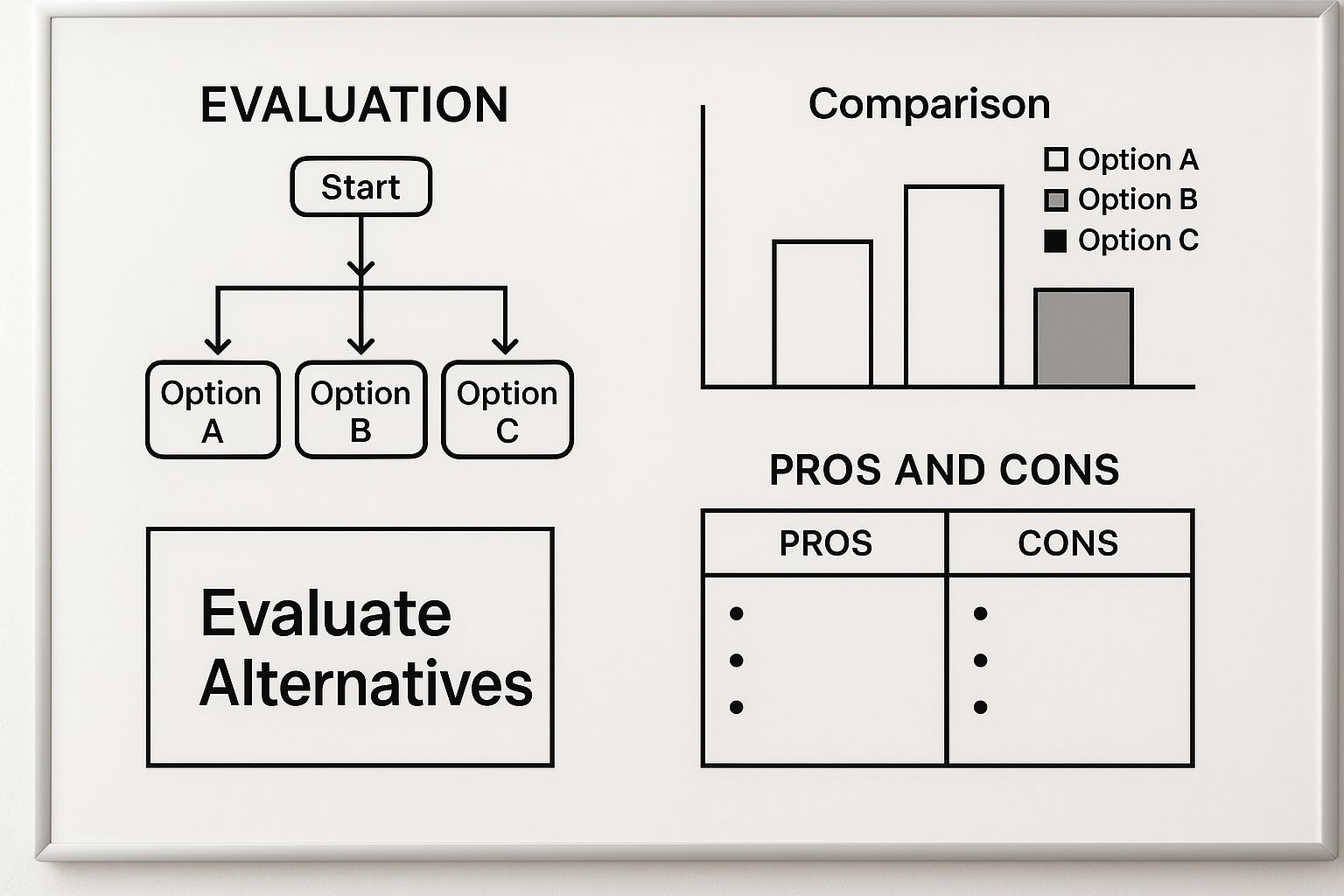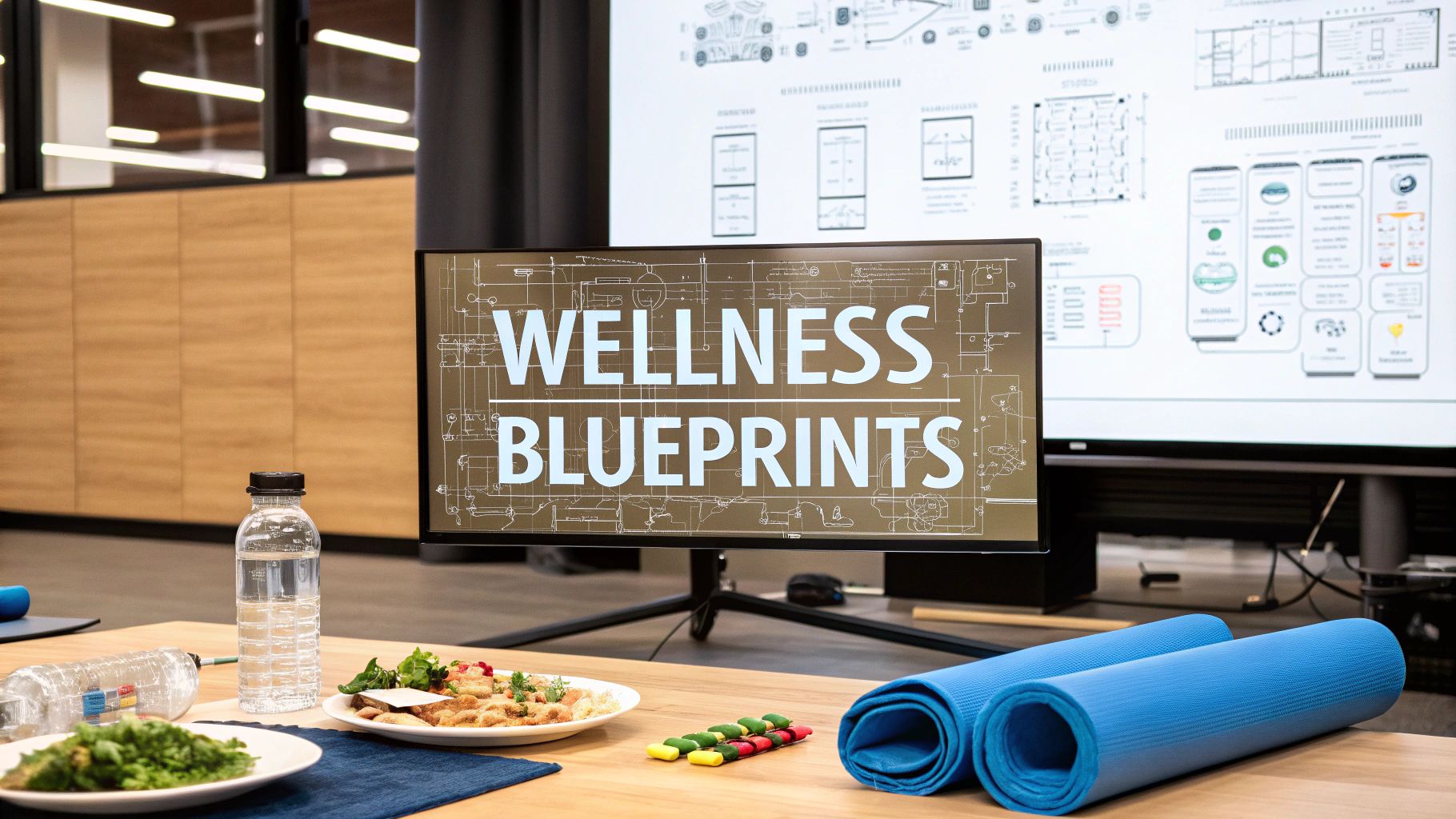Master the 5 Step Decision Making Process
Ever feel like you’re just spinning your wheels, stuck between a rock and a hard place when a big decision lands on your desk? We’ve all been there. The 5-step decision-making process is a lifesaver—think of it as a mental GPS that navigates you from a messy problem to a clear, confident solution.
Why a Decision-Making Framework Changes Everything
Workplace decisions are a mixed bag. Some are quick and easy, but others feel heavy, with the potential to affect everything from team morale to the bottom line. When you don’t have a plan, it’s all too easy to get tripped up by classic decision-making pitfalls, like making a gut call based on emotion or falling for confirmation bias.
This is exactly why having a formal framework is so powerful. It’s a built-in “pause” button that forces you to step back, look at the situation from all sides, and make a choice based on solid evidence, not just a hunch. You stop feeling paralyzed by “what ifs” and start building a repeatable system for making smarter calls.
The Power of a Process
Bringing structure to your decisions isn’t about creating more red tape—it’s about creating clarity. It gives your entire team a common language and a clear path forward, which is a massive advantage when tackling high-stakes challenges. When everyone is on the same page, communication clicks, and projects run smoother. In fact, we talk a lot more about how structure boosts teamwork in our guide on improving internal communication.
The numbers don’t lie. Research from UMass Dartmouth has shown that organizations with a formal decision-making process see a 25% higher success rate in their project outcomes.
By turning decision-making from an art into a science, you remove the guesswork and drastically improve your odds of success. It’s about being deliberate, not just decisive.
Before we get into the nitty-gritty of each stage, let’s start with a quick fly-by of the entire framework.
Here’s a simple table that breaks down the 5 steps we’re about to explore. Think of it as your cheat sheet for the whole process.
The 5 Step Decision Making Process at a Glance
| Step | Stage Name | Primary Goal |
|---|---|---|
| 1 | Define the Goal | Clearly identify the specific problem you need to solve. |
| 2 | Gather Intelligence | Collect relevant data and insights to inform your choice. |
| 3 | Brainstorm Options | Generate a wide range of potential solutions. |
| 4 | Analyze Alternatives | Objectively evaluate each option against your criteria. |
| 5 | Make and Review | Select the best option and assess its outcome over time. |
Now that you have the big picture, let’s dive into what each of these steps looks like in the real world.
Defining Your Goal and Gathering Intelligence

Before you can nail a decision, you first need to know what you’re actually trying to solve. The first part of the 5 step decision making process is about getting specific. It’s about turning that vague “something’s not right” feeling into a clear, tangible goal. This is your chance to separate the real problem from all the noise and symptoms surrounding it.
For instance, maybe you hear your team grumbling, “Our project management software is awful.” That’s a start, but it’s just a feeling. A much stronger approach is to dig deeper and frame it as a specific, measurable objective.
Something like this: “We need a new project management tool that integrates with Slack, can support 50 users, and will cut down the time we spend on reporting by 20%.” See the difference? Now you have a target you can actually aim for.
A poorly defined problem almost always leads to a poor solution. If you get this first part right, you’ve already won half the battle.
Collecting the Right Information
With a clear goal in hand, it’s time to put on your detective hat. Gathering intelligence isn’t just about grabbing every bit of data you can find—that’s a quick recipe for analysis paralysis. The real skill is in collecting the right information.
To keep from getting swamped, I’ve found it helps to focus your efforts on a few key areas:
- Internal Feedback: Your team is on the front lines. Go talk to the people who will be most affected by this decision. What are their biggest headaches with the current setup? What do they absolutely need in a solution? Their insights are pure gold.
- External Research: Look beyond the sales pitches. Hunt down unbiased reviews, real-world case studies, and what your competitors are doing. If you’re picking a new software vendor, you want to know what actual users are saying, not just what the marketing materials claim.
- Expert Consultation: Don’t be afraid to tap into the wisdom of others. This could be a quick chat with a department head who’s been through something similar or a trusted contact in your industry. A ten-minute conversation can often save you days of digging.
Pulling your team into this fact-finding mission is also one of the best keys to increasing employee engagement. It signals that you value their expertise and perspective. By laying this solid groundwork of a clear goal and targeted information, you make the entire process smoother and set yourself up for a much better outcome.
Time to Get Creative: Let’s Brainstorm Every Possible Option
You’ve defined your goal and done your homework. Now comes what I think is the most energizing part of the 5 step decision making process: coming up with all your potential solutions.
The key here is to let go of finding the perfect answer right out of the gate. Think of it more like casting a wide net. The mission is to explore every single possibility, even the ones that feel a little wild or unconventional.
Seriously, hold back on judging any ideas just yet. For now, it’s all about quantity over quality. When you let ideas flow freely without a critique, you open the door for genuinely innovative solutions to surface—the kind you’d completely miss otherwise.
Don’t Just Stick to the Obvious Choices
Let’s circle back to that software vendor example. Your first thought might be to just list the two or three big players everyone’s heard of. But a really effective brainstorming session pushes you way beyond that.
Your list of possibilities should be much broader and could include things like:
- The Industry Giants: Sure, list the well-known, established platforms.
- Up-and-Coming Startups: What about smaller, hungry companies with unique features?
- Open-Source Tools: Could a free or low-cost, customizable option work?
- A DIY Approach: Is it possible to adapt a tool you already use or even build something simple in-house?
Getting a diverse mix of options on the table is so important. It stops you from getting tunnel vision and ensures the decision you make later is a truly well-rounded one. A great tip? Pull in a small group of people from different departments. Fresh eyes and different viewpoints are incredible for sparking unexpected, game-changing ideas.
One option I always insist on adding to the list is “do nothing at all.” It acts as a baseline. This simple trick forces you to honestly measure every other idea against your current reality, which is an incredibly valuable point of comparison.
Once you’re done, you should have a solid, unfiltered list of potential paths. This list is the raw material you’ll start to shape and refine as you move forward, getting you that much closer to a decision you can feel great about.
How to Actually Analyze Your Options
Alright, you’ve brainstormed and have a solid list of potential solutions. Now comes the hard part—and arguably the most important one in the 5-step decision-making process. It’s time to shift gears from creative thinking to a more structured, logical evaluation.
This is where we take the emotion and gut feelings out of the equation and let the data do the talking. The best way I’ve found to do this is with a simple scoring system. It sounds more formal than it is, but it’s a fantastic way to objectively compare your choices.
Building Your Decision Matrix
Let’s stick with the software vendor scenario. Before you even look at demos, you need to know what you’re measuring them against. Get your team in a room and decide on the absolute “must-haves.”
What really matters? Your list of criteria might look something like this:
- Cost: The total, all-in price. No hidden fees.
- Key Features: Does it do the specific things we absolutely need it to do?
- User-Friendliness: How steep is the learning curve for our team?
- Support: When things go wrong (and they will), how good is their support team?
Once you have your criteria, give each one a “weight” on a scale of 1 to 5. A 5 means it’s a non-negotiable deal-breaker, while a 1 or 2 is more of a “nice-to-have.” If your budget is tight, Cost gets a 5. Simple as that. This step ensures that the final decision truly aligns with your priorities.
This methodical approach mirrors what you’d see in other structured frameworks. In fact, it’s a core component of many problem-solving techniques. You can see a lot of overlap with these 5 steps of problem solving.
Now you can start scoring each option against your criteria. A simple spreadsheet is perfect for this. When you multiply the scores by their weights and add them up, you’ll get a clear, data-backed picture of which option comes out on top.
This is where a simple comparison matrix can be a lifesaver. It lays everything out in black and white.
Example Software Vendor Comparison Matrix
| Criteria (e.g., Cost, Features, Support) | Weight (1-5) | Vendor A Score | Vendor B Score | Vendor C Score |
|---|---|---|---|---|
| Total Cost | 5 | 3 | 5 | 2 |
| Essential Features | 5 | 4 | 4 | 5 |
| Ease of Use | 3 | 5 | 3 | 3 |
| Customer Support | 2 | 3 | 4 | 5 |
| Weighted Total | — | 56 | 57 | 54 |
Looking at this table, you can see that even though Vendor C had the best features and support, Vendor B’s excellent cost score—our highest-weighted criteria—pushed it just slightly into the lead. This is the kind of clarity a matrix provides.

Think of this process like whiteboarding your ideas. You’re mapping out all the pros and cons in a structured way to see the whole picture, making sure your final choice is one you can stand behind.
The real win here isn’t just about picking the “best” option. It’s about having a transparent, defensible reason for your choice. When your boss asks why you went with Vendor B, you can confidently walk them through the data that proves it was the right call for the team’s specific needs.
Taking the Plunge and Looking Back

Alright, you’ve done the hard work. You’ve weighed the options, crunched the numbers, and now it’s time to actually make the call. This final part of the 5 step decision making process is really about two things: committing to a choice and, just as crucially, learning from what happens next.
Once your analysis is done, one path usually stands out as the smartest move. Your job now is to confidently make that decision and, more importantly, sell it to your team. Don’t just announce the new plan; walk them through the “why.” Explaining your reasoning, based on the solid evaluation you just did, helps build trust and gets everyone on the same page.
It’s also smart to think about potential roadblocks. For example, rolling out new software almost always comes with some grumbling and a bit of a learning curve. Being prepared to manage your team’s concerns is what makes for a smooth rollout. If you’re worried about navigating those conversations, our guide on how to handle difficult coworkers has some great tips.
Setting Up a Feedback Loop
Making the decision and walking away is a rookie mistake. The best leaders I know treat every choice as a chance to learn by building in a way to review the outcome.
So, you’ve launched the new software. Great. Now, put a follow-up meeting on the calendar for 30 or 90 days from now. This is your feedback loop—it’s non-negotiable.
When you all get together, you need to ask some honest questions:
- Did this actually fix the problem? Is the new tool really saving us time on reporting?
- What has the real-world impact been? How’s the team adapting? Did any unexpected issues—or benefits—pop up?
- What can we learn from this? What would we do differently next time?
This kind of reflection is what truly sharpens your skills. In fact, companies that consistently review their decisions see long-term project success rates jump by as much as 20%.
The whole point of a solid decision-making process isn’t to be perfect every time. It’s about stacking the deck in your favor and making sure you learn something valuable from every outcome, whether you win or lose.
By committing to this final step, you transform every decision into an opportunity to get better. Your team gets smarter, more adaptable, and ready for whatever challenge comes next.
Common Questions About This Decision Process
Even with a great framework, hitting the ground running with a new process always brings up a few questions. Let’s walk through some of the most common things people ask about the 5-step decision-making process so you can apply it with confidence.
One of the biggest concerns I hear is that the process seems too formal or rigid for every little thing. The good news is, it’s far more adaptable than it looks on paper.
Can I Use This Process for Quick Decisions?
You bet. This framework isn’t just for big, complex problems that require a two-hour meeting and a detailed spreadsheet. For smaller, day-to-day choices, you can run through the steps mentally in just a couple of minutes.
Treat it like a quick mental checklist. What’s the real issue? (“Which of these three tasks should I tackle first?”) What are my options? (“Project A is urgent, B is important but not due, C is a quick win.”) What does the evidence say? (“Project A has the tightest deadline and the biggest impact.”) Then, make the call.
The real power here is building the habit of structured thinking, so it becomes second nature even when you’re moving fast.
The most common mistake I see? People jump straight from identifying a problem to brainstorming solutions based on gut feelings or old habits. They completely skip the information-gathering step, which almost always leads to a weak, uninformed choice.
Another classic error is blowing past the final step: reviewing the outcome. If you don’t create that feedback loop, you never truly learn from your choices and are bound to repeat the same mistakes down the line.
What if My Team Reaches a Deadlock?
It’s bound to happen. When your team is stuck and can’t agree on a path forward, it’s usually a signal to rewind and look at your evaluation criteria again. Is there a fundamental disagreement on what matters most?
Go back to that step and have an honest conversation about the priorities you set. Often, just getting everyone on the same page about what you’re truly optimizing for—cost, speed, user experience—makes the best option obvious. If half the team is laser-focused on budget and the other half is all about innovation, you’ll need to align on that core priority before you can move forward.
If you’re still at an impasse, someone has to make the final call. But the beauty of this process is that the decision-maker can use all the objective data and arguments gathered to make a choice that’s transparent and easy to explain. Bringing your team along for the ride like this is also a great way to boost team morale by showing that you genuinely value their input.
At JIMAC10, we’re all about helping you create a workplace where clear thinking and strong collaboration are the norm. To find more practical insights and join a community focused on professional growth, come visit us at https://jimac10.tube.
Share this content:







































1 comment